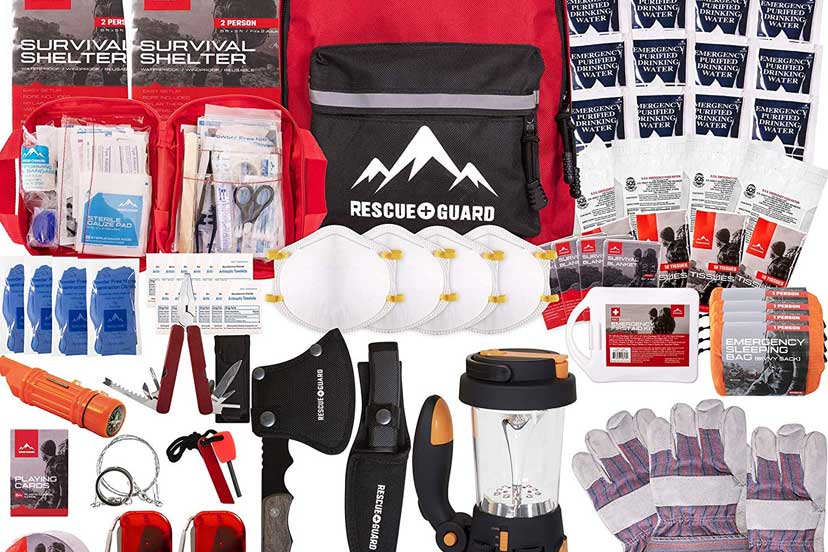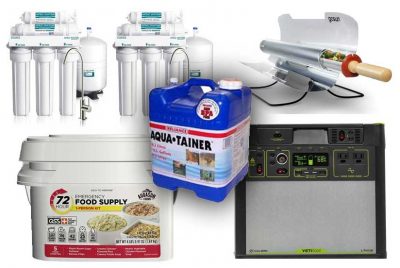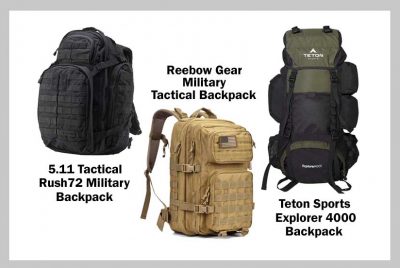There are lots of cheap prepper supplies that are great for building a beginner's survival kit.…
Build a Cheap 3 Day Survival Kit from Scratch

An emergency situation or natural disaster can happen at any time. Hurricanes, tornadoes, severe winter storms, earthquakes, or even pandemics, can occur without any notice. The more you know about how to prepare for when the unexpected happens, the better chance you’ll have at thriving, not just surviving, during that disaster. And the best way to prepare for these emergencies is by building a quality 3 day survival kit for each family member.
A 72 hour survival kit needs to include food, water, and some vital survival tools. But simply buying items to add to your 3 day survival kit isn’t all there is to it. You also need to make a list of everything in your 72 hour pack, as well as know how and when to use each item.
Build a 72 Hour Emergency Kit for All Seasons
When building your 72 hour emergency kit, make sure you prepare for both the coldest and hottest times of the year in your location. If a disaster happens in the middle of a winter blizzard, but all you have is a summer survival kit, you may find your odds of survival decreased. Plan for different disaster or weather scenarios, such as winter storms, heavy rain, hurricane-force winds, floods, and fires.
In extreme cases, you may have to evacuate your home at a moment’s notice. If you find yourself abandoning your home, be sure to have a 3 day survival kit ready to grab a go. The following 3 day survival kit list will give you an idea as to what should be included for each season. But remember, depending on your location and climate, your requirements may be different than someone else’s.
Water
This is always the number one ingredient for any emergency survival pack. Experts say you need about a half gallon of water per day for drinking. However, if you have room in your kit for more, include a gallon per person per day. The extra water can be used for cleaning and other tasks. It’s also a good idea to pack water purification tablets and a water purifying system as well. The LifeStraw Water Filter and Sawyer Squeeze Water Filter are both good, lightweight options.
Food
If you’re not forced to abandon your home, almost any type of food can be stored and used. But if you have canned food, be sure to have a manual can opener in case the power goes out. If you find yourself on the move, and carrying your survival food in a backpack, it’s a whole new ballgame. You want foods that are high in calories and yet lightweight. Foods like the Datrex Emergency Food Bars are highly concentrated and lightweight. Powdered soups and dehydrated foods are also easy to carry and can be mixed with boiling water to make delicious meals. Remember to bring plastic plates, cups, and eating utensils.
Clothing
Depending on the weather you’ll want to pack waterproof boots or shoes, waterproof pants and jacket, extra socks and underwear, hat, sunglasses, bandana, and poncho. You’ll want to pack clothes that will help keep you warm and dry as much as possible.
Shelter
Being exposed to snow, rain, or sun can make life miserable. A simple, lightweight, tarp shelter is the easiest way to provide a barrier between you and the environment. Be sure to pack paracord as well, in case it’s necessary to attach the tarp to trees or other items. A small portable survival tent is another option. Sleeping bags, blankets, and pads are all great items to include in your 3 day survival pack if you have the room. Just make sure they’re extremely lightweight and easy to carry.
First Aid Kit
You can build your own survival kit by simply including a container filled with band-aids, ACE bandages, gauze strips, and tape. However, if you’re going to buy a pre-made first aid kit, be sure it includes all the essential first aid items. Pre-made first aid kits may also include antiseptic cream, scissors, soap, thermometer, and other items.
You’ll also want to include some pain relief pills, as well as any medications you or your family are taking. This may include both prescription and non-prescription medicines such as antibiotics, antihistamine, or insulin.
Important Family Information
It’s important to bring along a notepad filled with important information. This can include emergency phone numbers and family phone numbers. If you’ve abandoned your home and want to contact emergency personnel or family, you want the necessary information at your disposal.
Mobile Phone and Emergency Radio
In some emergency situations you may not be able to use your phone. This can happen because of overcrowding of phone lines or being out of cell reception. In these situations you’ll want to have an emergency radio available. A portable, hand crank, solar powered emergency radio can keep you updated on weather conditions and the status of your emergency situation.
Portable Solar Power Supply
Mobile phones can come in hand during an emergency, but only if they’re charged up. A portable solar power supply can make sure your phone and other electronic devices remain charged. Just be sure to bring all necessary cables and adapters for charging your devices.
Plastic Bags
Large trash bags have many uses. They can be made into ponchos, keep your first aid and survival supplies dry, keep your shoes dry, and be made into a sling, just to name a few uses.
Important Survival Tools
Along with the survival essentials we’ve already listed, there are a few survival tools you’ll want to include in your 72 hour kit. A waterproof flashlight, small folding knife, windproof and waterproof matches, cooking stove, and extra batteries are all important items to include. And if you’ve got room in your survival bag for a strong, durable, full tang knife, even better. A good knife serves many purposes, but can also offer protection against other survivalists.
More Essential Survival Gear
A local map and compass can help keep you from getting lost, especially if you’re in a wilderness environment. However, if you do get lost, having a personal locator beacon can give searchers or rescuers your location. A survival whistle or rescue mirror are two cheaper alternatives to help you get found, but are not as reliable as a personal locator beacon.
Paracord or nylon rope has many uses and is always a great item to include in 3 day survival kits. Other supplies that can be included in emergency survival kits are sunscreen, umbrella, towels, insect repellent, and folding shovel. Folding shovels that have serrated edges can also be used to cut wood into kindling for fires.
72 Hour Pack Final Thoughts
If you are building kits for other family members, such as a spouse and kids, you’ll want to prepare a kids survival kit or family survival kit instead of, or in addition to, your own. However, if your children are small, they may not be able to carry anything. So be sure to pack additional items for your kids in your kit. And if you own a dog, you’ll want to have some type of dog bug out bag or saddle bag so that your dog can carry a few items that they will need.
Checking your 3 day survival kit periodically, and replacing any survival gear, food, or water that needs replacing, is also important. And lastly, make sure you know how to use any tools and cook any food you’ve added to your kit. You don’t want to find yourself in an emergency situation where you don’t know what to do with the survival gear you’ve packed.



